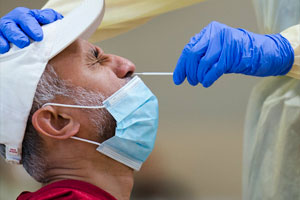 Viruses that are primarily acquired via a respiratory route, such as SARS-CoV-2, are typically diagnosed through direct detection of viral components in respiratory specimens. The two most frequently used tools to do this are nucleic acid amplification tests via polymerase chain reaction (PCR) or antigen-based tests.
Viruses that are primarily acquired via a respiratory route, such as SARS-CoV-2, are typically diagnosed through direct detection of viral components in respiratory specimens. The two most frequently used tools to do this are nucleic acid amplification tests via polymerase chain reaction (PCR) or antigen-based tests.
When the COVID-19 pandemic began, reverse-transcriptase PCR (RT-PCR) tests were the first to be developed and widely deployed and remain the primary tool used for diagnosis. While antigen tests are also being used and developed, they are not yet widely available and currently have variable reliability.
SARS-CoV-2 RT-PCR detects viral RNA; a positive result is highly specific for the presence of the virus. The sensitivity of these tests is not uniform, and is affected not only by the assay itself, but also the limit of detection, viral inoculum, timing of testing, and sample collection site. Direct viral detection assays may be based on several gene targets and vary in sensitivity and specificity.
Here, we focus on science related to the sensitivity of RT-PCR SARS-CoV-2 tests, including viral dynamics, the effects of timing of testing in relation to symptom onset, sample sites, and the implications of persistent positivity.
Many companies and labs have developed tests to diagnose COVID-19 based on detection of the virus’s genetic material in a sample from the patient’s nose or throat. These steps may change as new technology becomes available, but currently the typical steps in molecular testing are:
1. A doctor, pharmacist, or other health professional orders a COVID-19 test. All COVID-19 tests, including those used with a home collection kit, require a prescription or order from a health professional.
2. You or a health care professional use a specialized swab to collect mucus from your nose or throat.
3. You or a health care professional put the swab in a sterile container and seal it for transport to a lab.
4. During the shipping process, most molecular test swabs must be kept within a certain temperature range so that the test will be accurate. The sample must arrive at the lab within 72 hours.
5. A lab technician mixes liquids with the swab to extract the genetic material of any virus that may be on the swab.
6. The lab technician uses special reagents, called primers and probes, and a high-tech machine to conduct several controlled heating and cooling cycles to convert the virus’s RNA into DNA, and then make millions of copies of the DNA. Some tests use only one warming cycle to make copies of the DNA.
7. When specific probes bind to DNA, a special type of light is produced that can be seen by the machine and the test shows a “positive” result for infection with SARS-CoV-2, the virus that causes COVID-19.